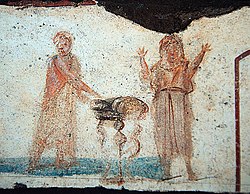Transubstantiation
Transubstantiation is a teaching, and Catholic doctrine which says that, after a priest consecrates them, the bread and wine at a Catholic Mass become the body and blood of Jesus. Christians believe Jesus is the son of God.
According to this teaching the appearance, smell, and taste of bread and wine do not change. However, the substances of bread and wine have actually changed into the body and blood of Jesus.
Transubstantiation is also taught by some other Christian churches.
Beliefs about transubstantiation
Christians who believe in transubstantiation believe that the bread they eat at Mass is the body of Jesus. They know that the bread still tastes like bread, looks like bread and smells like bread. It is just like bread, but it becomes the body of Jesus. The priest says prayers at Mass so that the bread and wine become the flesh and blood of Jesus.
This started when Jesus ate a meal called the Last Supper the night before he died. He said that the food his friends were eating was his body and blood. In the Gospel of Matthew 26:26-27, Jesus says to his Apostles:
Take this [bread] all of you and eat it. This is my body which will be given up for you. [...] Take this [cup] all of you and drink from it. This is the cup of my blood, the blood of the new and everlasting covenant. [...] My blood will be shed for you and for all so that sins may be forgiven. [...] Do this in memory of me.
According to the idea of transubstantiation, this means:
- Jesus's blood would make a promise forever between God and his people
- Jesus would die for everyone so their sins (the things they do wrong) could be forgiven
- Jesus commanded people to continue taking Holy Communion
Many people did continue to take Communion after Jesus was killed by crucifixion. For these people, the Eucharist is a reminder of the Last Supper.
Transubstantiation Media
The Eucharist, which the Catholic Church teaches to be the real presence of Christ, exposed for adoration at Saint Thomas Aquinas Cathedral in Reno, Nevada
A 3rd-century fresco in the Catacomb of Callixtus, interpreted by the archaeologist Joseph Wilpert as showing on the left Jesus multiplying bread and fish, a symbol of the Eucharistic consecration, and on the right a representation of the deceased, who through participation in the Eucharist has obtained eternal happiness
The Last Supper (upper image) and preparatory washing of feet (lower image) in a 1220 manuscript in the Baden State Library, Karlsruhe, Germany
Title page of Martin Luther's De Captivitate Babylonica Ecclesiae



